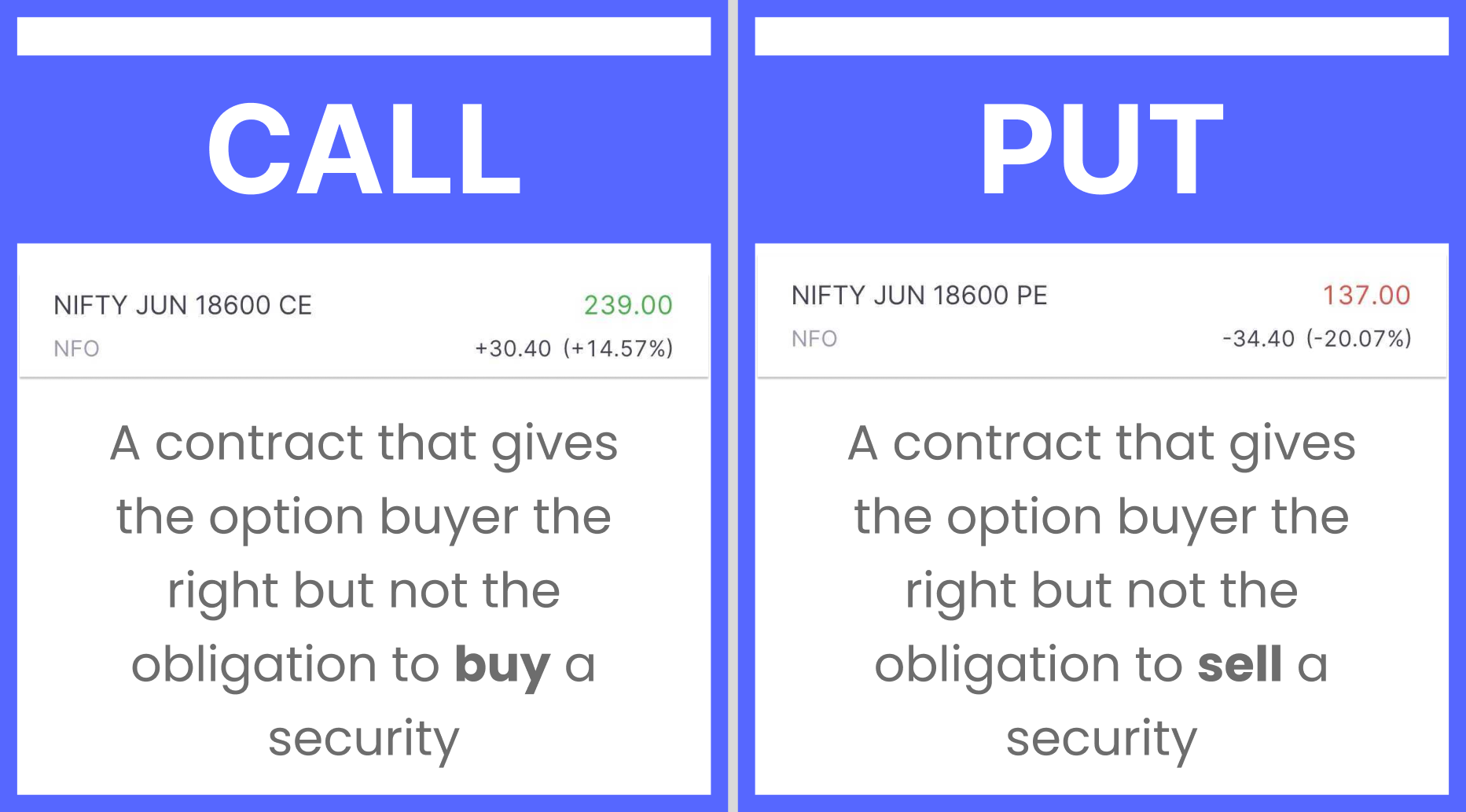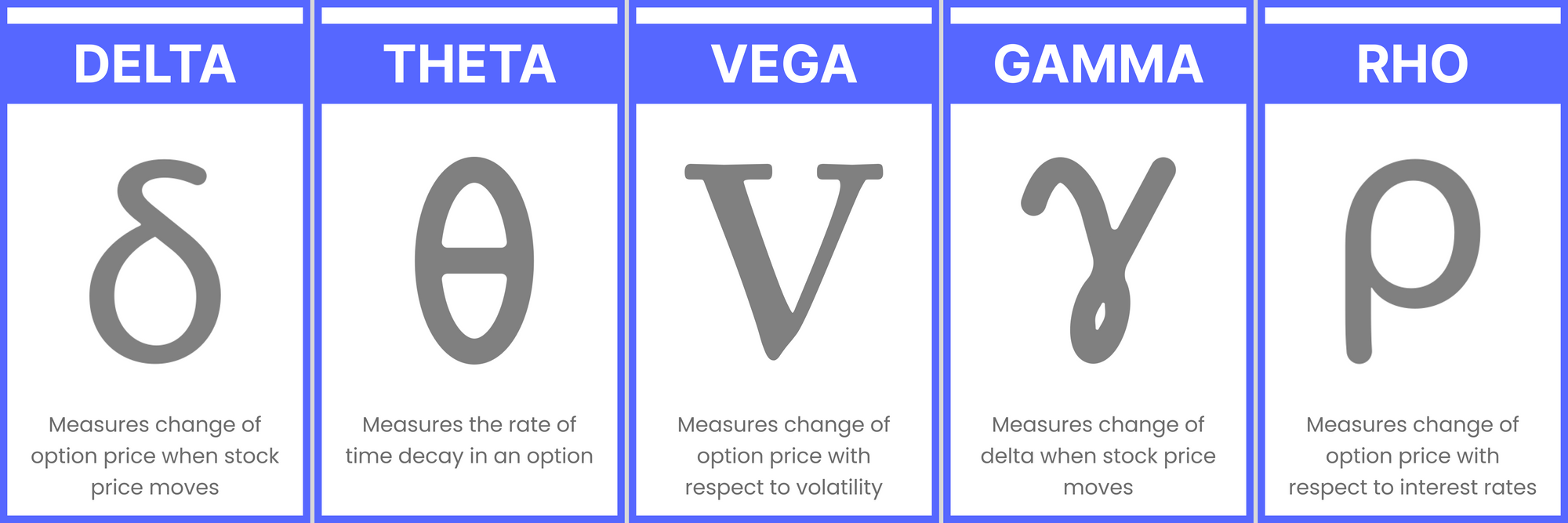What Are Options? Types Of Options & How To Use. A detailed Guide
Options are derivative tools where investors have the right, but not the obligation, to buy or sell a particular asset at a specific price and time. Stock market options are contracts for buying or selling an asset at a specific price and on a future date.

What Are Options?
Just as the name suggests, options are financial tools that grant the right or the option to buy or sell an underlying asset at a set price and on a future date. They are used for hedging, speculation, or arbitrage in the stock markets.
Types Of Option Contracts
Options can be categorised into two main parts, Call and Put options. Let’s understand more about each of them.
- Call Options
A call option gives the holder the right, but not the obligation, to buy an underlying asset at a predetermined price, known as the strike price, at or before the option's expiration date.
- Put Options
A put option gives the holder the right, but not the obligation, to sell an underlying asset at a predetermined price, known as the strike price, at or before the option's expiration date.
Call options and put options work by giving the holder the right, but not the obligation, to buy or sell an underlying asset at a predetermined price and date. The holder can choose to exercise the option if it is profitable to do so.

The main difference between call and put options is the right they provide to the holder. A call option gives the holder the privilege to purchase the underlying asset, whereas a put option allows the holder to sell the underlying asset. In options trading, the buyer pays a premium to the seller for the option, and the seller must honour the contract if the buyer decides to exercise their option. Call options are generally used to speculate on upward price movements, while put options are used to speculate on downward price movements or for hedging purposes.
How To Use Call and Put Options
Call options can be used for various trading strategies, including buying calls to profit from upward price movements, selling covered calls for income generation, and using call options in combination with other strategies to manage risk. An example of using call options is when an investor purchases a call option on a stock, they expect to increase in value.
Put options can be used for different trading strategies, such as buying puts to profit from downward price movements, selling cash-secured puts for income generation, and using put options to hedge against market volatility. An example of using put options is when an investor purchases a put option on a stock, they expect to decrease in value or hedge against potential losses.
Before we get into some of the advanced metrics for options, let’s look at some basic terms used in options trading.
- Strike price: The strike price is the price at which the option holder can buy or sell the underlying asset if they decide to exercise their option. It is also known as the exercise price.
- Expiration date: The expiration date is when the option contract expires. After this date, the option becomes worthless and cannot be exercised.
- Premium: The premium is the price the option buyer pays the option seller for the right to buy or sell the underlying asset. It represents the cost of the option and is determined by supply and demand in the market.
- Intrinsic value: The intrinsic value is the difference between the underlying asset's current price and the option's strike price. For call options, if the current price is higher than the strike price, the option has a positive intrinsic value. For put options, if the current price is lower than the strike price, the option has a positive intrinsic value.
- Time value: The time value is the difference between an option's premium and intrinsic value. It represents the option's value based on the time remaining until expiration and factors such as volatility and interest rates.
- Open interest: Open interest is the number of outstanding option contracts that have not been exercised, closed, or expired. It represents the total number of contracts that are held by buyers and sellers in the market and can provide insight into the level of trading activity in a particular option.
What Is Options Trading?
Trading options is similar to stock trading, but the trader has the opportunity to buy or sell an underlying asset at a predetermined price and date. However, investors are not obliged to do so. Options can be used to generate income, hedge against risk or for speculation purposes.
Options trading can allow investors to manage risk, hedge against market volatility, and generate high returns. Options trading can be used with other investment strategies to build a diversified portfolio.
Options trading differs from other financial instruments because it allows investors to buy or sell an underlying asset at a specific price and time without owning it. This might offer potentially higher returns but also increases the risk.
The ability to manage risk, flexibility, and potential for high returns are some of the advantages of options trading. The potential for high risk, complexity, and the need for a strong understanding of the market and trading strategies are some downsides of options trading.
Options Pricing
The process of evaluating the worth of an options contract is referred to as options pricing. The price of an options contract is based on various factors that affect the underlying asset's price and market conditions.
Options are priced using mathematical models, like the Options Greeks. These Greeks consider factors such as the underlying asset's price, time until expiration, volatility, interest rates, and strike price.

The main factors that affect options pricing include the underlying asset's price, time until expiration, volatility, interest rates, and strike price. Changes in any of these can affect an option's price.
Premium Pricing Options
The main factors that affect premium pricing include the underlying asset's price, time until expiration, volatility, interest rates, and strike price. Factors like market sentiment, supply and demand, and geopolitical events, can also affect premium pricing.
For example, if an investor purchases a call option on a stock with a strike price of Rs. 50 and an expiration date in six months, the option's premium will be influenced by the stock's current price, volatility, and the time until expiration. If the stock price rises above Rs. 50, the option will be in-the-money, and the premium will increase. Conversely, if the stock price falls below Rs. 50, the option will be out-of-the-money, and the premium will decrease.
Things Every Options Trader Should Be Aware Of
- Common mistakes to avoid
Failing to understand the risks involved, overtrading, not having a clear trading plan, not managing risk effectively, and chasing quick profits without proper analysis and research are some of the mistakes you should avoid in options trading.
- Tips for successful options trading
Educating yourself on the options market, having a clear trading plan, managing risk effectively, avoiding overtrading, staying disciplined, and using technical and fundamental analysis can help options traders make informed trading decisions.
- Importance of research and analysis in options trading
Research and analysis are crucial for success in options trading. Investors must evaluate market conditions, analyse stock and options price movements, assess volatility, and track market trends to make informed trading decisions. Conducting proper research and analysis can help traders manage risks and increase the likelihood of successful trades.
Risks Involved in Options Trading
Options trading comes with several risks, including market volatility, time decay, interest rate, and liquidity risks. These risks can lead to substantial losses for options traders.
To manage risks in options trading, investors can use strategies such as diversification, stop-loss orders, limiting trade size, hedging, and avoiding overtrading. Options traders should also clearly understand the risks involved in options trading and manage their trades accordingly.
Risk management is crucial in options trading as it helps traders avoid significant losses and protect their trading capital. By effectively managing risks, options traders can stay in the market long-term and increase their chances of success.
Conclusion
Options trading provides investors with a versatile tool to hedge their portfolios, generate income, and manage risk. Options can also offer high leverage, low transaction costs, and flexibility in trading strategies, making them valuable investment tools.
While options trading offers significant benefits, investors should start cautiously trading options. Understanding the risks involved in options trading and having a clear trading plan is also essential. Beginners should educate themselves on the options market, start small, and avoid overtrading to avoid significant losses.
Summary:
- Options trading allows investors to buy or sell assets at a specific price and time, providing opportunities for risk management, volatility hedging, and high returns.
- Options are financial tools granting the right to buy or sell underlying assets, categorised as call options (buying) and put options (selling).
- Call options can be used for upward price speculation, income generation, and risk management, while put options can be used for downward price speculation or hedging.
- Options pricing is influenced by factors such as the underlying asset's price, expiration date, volatility, interest rates, and strike price.
- Successful options trading requires risk management, a clear trading plan, research and analysis, and avoiding common mistakes like inadequate risk management and overtrading.
Want to receive the next blog in your mail? Click on the subscribe button and receive the next blog in your mail.



